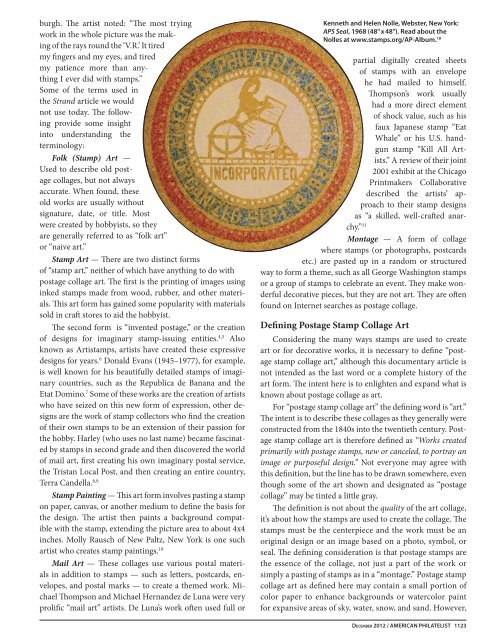21st-Century Postage Stamp Collage Artists - American Philatelic ...
21st-Century Postage Stamp Collage Artists - American Philatelic ...
21st-Century Postage Stamp Collage Artists - American Philatelic ...
You also want an ePaper? Increase the reach of your titles
YUMPU automatically turns print PDFs into web optimized ePapers that Google loves.
urgh. The artist noted: “The most trying<br />
work in the whole picture was the making<br />
of the rays round the ‘V.R.’ It tired<br />
my fingers and my eyes, and tired<br />
my patience more than anything<br />
I ever did with stamps.”<br />
Some of the terms used in<br />
the Strand article we would<br />
not use today. The following<br />
provide some insight<br />
into understanding the<br />
terminology:<br />
Folk (<strong>Stamp</strong>) Art —<br />
Used to describe old postage<br />
collages, but not always<br />
accurate. When found, these<br />
old works are usually without<br />
signature, date, or title. Most<br />
were created by hobbyists, so they<br />
are generally referred to as “folk art”<br />
or “naive art.”<br />
<strong>Stamp</strong> Art — There are two distinct forms<br />
of “stamp art,” neither of which have anything to do with<br />
postage collage art. The first is the printing of images using<br />
inked stamps made from wood, rubber, and other materials.<br />
This art form has gained some popularity with materials<br />
sold in craft stores to aid the hobbyist.<br />
The second form is “invented postage,” or the creation<br />
of designs for imaginary stamp-issuing entities. 4,5 Also<br />
known as Artistamps, artists have created these expressive<br />
designs for years. 6 Donald Evans (1945–1977), for example,<br />
is well known for his beautifully detailed stamps of imaginary<br />
countries, such as the Republica de Banana and the<br />
Etat Domino. 7 Some of these works are the creation of artists<br />
who have seized on this new form of expression, other designs<br />
are the work of stamp collectors who find the creation<br />
of their own stamps to be an extension of their passion for<br />
the hobby. Harley (who uses no last name) became fascinated<br />
by stamps in second grade and then discovered the world<br />
of mail art, first creating his own imaginary postal service,<br />
the Tristan Local Post, and then creating an entire country,<br />
Terra Candella. 8,9<br />
<strong>Stamp</strong> Painting — This art form involves pasting a stamp<br />
on paper, canvas, or another medium to define the basis for<br />
the design. The artist then paints a background compatible<br />
with the stamp, extending the picture area to about 4x4<br />
inches. Molly Rausch of New Paltz, New York is one such<br />
artist who creates stamp paintings. 10<br />
Mail Art — These collages use various postal materials<br />
in addition to stamps — such as letters, postcards, envelopes,<br />
and postal marks — to create a themed work. Michael<br />
Thompson and Michael Hernandez de Luna were very<br />
prolific “mail art” artists. De Luna’s work often used full or<br />
Kenneth and helen nolle, Webster, new York:<br />
APS Seal, 1968 (48" x 48"). read about the<br />
nolles at www.stamps.org/AP-Album. 18<br />
partial digitally created sheets<br />
of stamps with an envelope<br />
he had mailed to himself.<br />
Thompson’s work usually<br />
had a more direct element<br />
of shock value, such as his<br />
faux Japanese stamp “Eat<br />
Whale” or his U.S. handgun<br />
stamp “Kill All <strong>Artists</strong>.”<br />
A review of their joint<br />
2001 exhibit at the Chicago<br />
Printmakers Collaborative<br />
described the artists’ approach<br />
to their stamp designs<br />
as “a skilled, well-crafted anarchy.”<br />
11<br />
Montage — A form of collage<br />
where stamps (or photographs, postcards<br />
etc.) are pasted up in a random or structured<br />
way to form a theme, such as all George Washington stamps<br />
or a group of stamps to celebrate an event. They make wonderful<br />
decorative pieces, but they are not art. They are often<br />
found on Internet searches as postage collage.<br />
Defining <strong>Postage</strong> <strong>Stamp</strong> <strong>Collage</strong> Art<br />
Considering the many ways stamps are used to create<br />
art or for decorative works, it is necessary to define “postage<br />
stamp collage art,” although this documentary article is<br />
not intended as the last word or a complete history of the<br />
art form. The intent here is to enlighten and expand what is<br />
known about postage collage as art.<br />
For “postage stamp collage art” the defining word is “art.”<br />
The intent is to describe these collages as they generally were<br />
constructed from the 1840s into the twentieth century. <strong>Postage</strong><br />
stamp collage art is therefore defined as “Works created<br />
primarily with postage stamps, new or canceled, to portray an<br />
image or purposeful design.” Not everyone may agree with<br />
this definition, but the line has to be drawn somewhere, even<br />
though some of the art shown and designated as “postage<br />
collage” may be tinted a little gray.<br />
The definition is not about the quality of the art collage,<br />
it’s about how the stamps are used to create the collage. The<br />
stamps must be the centerpiece and the work must be an<br />
original design or an image based on a photo, symbol, or<br />
seal. The defining consideration is that postage stamps are<br />
the essence of the collage, not just a part of the work or<br />
simply a pasting of stamps as in a “montage.” <strong>Postage</strong> stamp<br />
collage art as defined here may contain a small portion of<br />
color paper to enhance backgrounds or watercolor paint<br />
for expansive areas of sky, water, snow, and sand. However,<br />
December 2012 / AmericAn PhilAtelist 1123

















